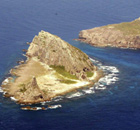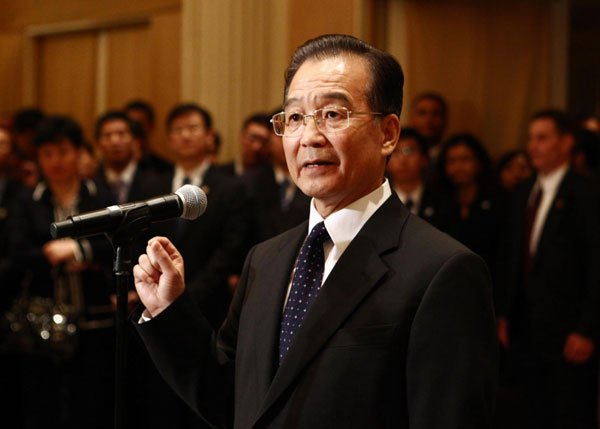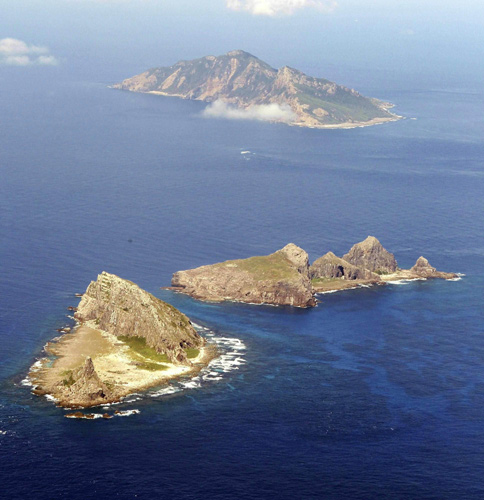-
-

-

-

-

'Late Autumn'
Tang Wei attends at the press conference during a Gala Presentation of 'Late Autumn' of the 15th Pusan Int'l Film Festival.

-
Foreign and Military Affairs
Sovereignty over Diaoyu Islands beyond doubt
(chinadaily.com.cn)
Updated: 2010-10-12 15:43
 |
Large Medium Small |
Historical facts and international law have made it an undeniable truth that the Diaoyu Islands belong to China, and the islands have no historical terra nullius status.
Chinese fishermen have been gathering herbs and fishing in the islands and the nearby waters for generations.
|
 Chinese Premier Wen Jiabao speaks during a meeting with representatives of Chinese nationals and Chinese Americans in the United States on Sept 21, 2010. He said the Diaoyu Islands are part of China's sacred territory. [Photo/Xinhua] |
Ever since the early period of the Ming Dynasty (1368-1644), the Diaoyu Islands have been clearly included in the territory and maritime defense sector of China and China's sovereignty over the islands was recognized by Japan, which used Chinese names to identify the area, until modern times.
| ||||
At the same time, related documents and maps of Britain, France, United States and Spain also showed the Diaoyu Islands belonging to China.
One noticeable example is a map made by the British Navy in 1877 - China East Coast: Hong Kong to Gulf of Liau-Tung, which marked the Diaoyu Islands as subsidiary islands of Taiwan Island, and separated them from the islands of Japan. Thereafter this map was used as reference for the signing of Treaty of Shimonoseki.
In January 1895, three months before the Treaty of Shimonoseki was signed between Japan and China, after the latter was defeated in the Sino-Japanese War of 1894-1895, Japan illegally took over the Diaoyu Islands and included them in its Okinawa Prefecture. It cannot be denied that the Diaoyu Islands were ceded to Japan as subsidiary islands of Taiwan in 1895 after the Treaty was signed.
However, in December 1943, leaders of the United States, Britain and China signed the Cairo Declaration, declaring that all the territories that Japan had seized from China should be returned. The Potsdam Proclamation signed by China, the United States and Britain in July 1945 (later adhered to by the Soviet Union) stipulated that: "The terms of the Cairo Declaration shall be carried out".
In August 1945, Japan accepted the Potsdam Proclamation and surrendered unconditionally, which means both documents came into effect.
|
 An aerial view shows part of?the Diaoyu Islands in this photo, Sept 29, 2010. [Photo/Agencies] |
After World War II ended, China took back its territories stolen by Japan, including Taiwan Island and its subsidiary islands. Therefore as part of the Taiwan Islands, the Diaoyu Islands were returned to China under international law.
However, in September 1951, Japan signed the San Francisco Peace Treaty with the US and other allied powers, and single-handedly surrendered the Diaoyu Islands, along with Okinawa, to the administration of Washington.
In response, Zhou Enlai, the then premier and foreign minister of China, sternly declared that a San Francisco treaty signed without the People's Republic of China's participation is unlawful and illegitimate.
In June 1971, Washington and Tokyo signed the "Okinawa Reversion Agreement", parceling up the "administrative rights" of Diaoyu Islands to Japan.
The Chinese Foreign Ministry in response issued a statement in December later that year, which said "the agreement is a blatant infringement on China's territorial sovereignty that is intolerable for the Chinese people. The US and Japan list China's Diaoyu and other islands into the agreement's 'reversion area' is completely unlawful. It cannot change the People's Republic of China's sovereignty right on those islands."
The US government afterwards repeatedly claimed that Washington's decision to reverse the "administrative rights" of Okinawa to Japan would not have any influence on the Diaoyu Islands' sovereignty dispute, thus hoping Beijing and Tokyo would solve the issue through consultation and negotiation.
The Chinese government has been resolvedly fighting over its sovereignty rights as the Japanese government continues its unlawful occupation of the Diaoyu and its surrounding islands.
Through repeated diplomatic negotiations and the Foreign Ministry's news conferences, Beijing has made clear its principled position on the issue.
In February 1992, Beijing issued the Law of the Peoples Republic of China Concerning Territorial Waters and Contiguous Zone, which clearly declared the Diaoyu Islands as Chinese territory. The Japanese government's denial of the sovereignty dispute is a breach of both human history and basic facts.






